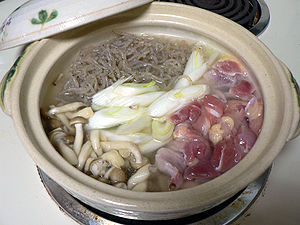
Shirataki noodles
Encyclopedia

Japanese noodles
Noodles are one of the main staples in Japanese cuisine. Many types are served chilled with dipping sauces in the summer, and in soups or hot dishes during the winter. Varieties include:...
made from devil's tongue yam (elephant yam or the konjac
Konjac
Konjac , also known as konjak, konjaku, konnyaku potato, devil's tongue, voodoo lily, snake palm, or elephant yam , is a plant of the genus Amorphophallus...
yam). The word "shirataki" means "white waterfall", describing the appearance of these noodles. Largely composed of water and glucomannan
Glucomannan
Glucomannan is a water-soluble polysaccharide that is considered a dietary fiber. Glucomannan is a food additive used as an emulsifier and thickener. Products containing glucomannan, marketed under a variety of brand names, are also sold as nutritional supplements for constipation, obesity, high...
, a water-soluble dietary fiber
Dietary fiber
Dietary fiber, dietary fibre, or sometimes roughage is the indigestible portion of plant foods having two main components:* soluble fiber that is readily fermented in the colon into gases and physiologically active byproducts, and* insoluble fiber that is metabolically inert, absorbing water as it...
, they have little flavor of their own.
Shirataki noodles can be found both in dry and soft "wet" forms in Asian markets and some supermarkets. When wet, they are purchased pre-packaged in liquid. They normally have a shelf life of up to one year. Some brands may require rinsing or par-boiling as the water they are packaged in has an odor that may be unpleasant to those not accustomed to it.
Alternatively, the noodles can be drained and dry roasted. This gets rid of the aku (bitterness). It also makes the noodles have a more pasta like consistency. Dry roasting is done by placing noodles in a non-stick skillet on high for a minute or until you hear a slight squeaking noise when moving them around. After that they are ready to be added to soup stock or have a sauce added to them.
There are two types of shirataki noodles sold in the United States. Traditional shirataki noodles have zero net carbohydrates, no food energy
Food energy
Food energy is the amount of energy obtained from food that is available through cellular respiration.Food energy is expressed in food calories or kilojoules...
, and no gluten, and they are useful for those on low-carbohydrate diet
Low-carbohydrate diet
Low-carbohydrate diets or low-carb diets are dietary programs that restrict carbohydrate consumption usually for weight control or for the treatment of obesity. Foods high in digestible carbohydrates are limited or replaced with foods containing a higher percentage of proteins and fats...
s. Tofu-based shirataki-style noodles are becoming increasingly popular in U.S. supermarkets and health food stores. They have a much shorter shelf life and require refrigeration even before opening. Tofu-based noodles contain a minimal amount of carbohydrate.
Source
The glucomannan noodles come from the root of an Asian plant called konjacKonjac
Konjac , also known as konjak, konjaku, konnyaku potato, devil's tongue, voodoo lily, snake palm, or elephant yam , is a plant of the genus Amorphophallus...
(full name amorphophallus konjac). It has been nicknamed elephant yam, and also called konjaku, konnyaku, or the konnyaku potato.
Other names
Shirataki also goes by the names "ito konnyaku," yam noodles, and devil's tongue noodles.Ito konnyaku and shirataki
There used to be a difference in manufacturing methods; in the Kansai region of Japan, ito konnyaku was prepared by cutting konnyaku jelly into threads, while in the Kantō regionKanto region
The is a geographical area of Honshu, the largest island of Japan. The region includes the Greater Tokyo Area and encompasses seven prefectures: Gunma, Tochigi, Ibaraki, Saitama, Tokyo, Chiba, and Kanagawa. Within its boundaries, slightly more than 40 percent of the land area is the Kantō Plain....
, shirataki was prepared by extruding konnyaku sol through small holes into a hot lime solution in high concentration. Nowadays, both are prepared using the latter method. Ito konnyaku is generally thicker than shirataki, with a square cross section and a darker color. It is preferred in the Kansai region.
External links
- Konnyaku and Shirataki FAQ What they are made of, historical background, use as diet food with caveats on JustHungry.com
- Shirataki Noodle Recipes Large collection of Shirataki Noodle recipes. Over 100 recipes.

